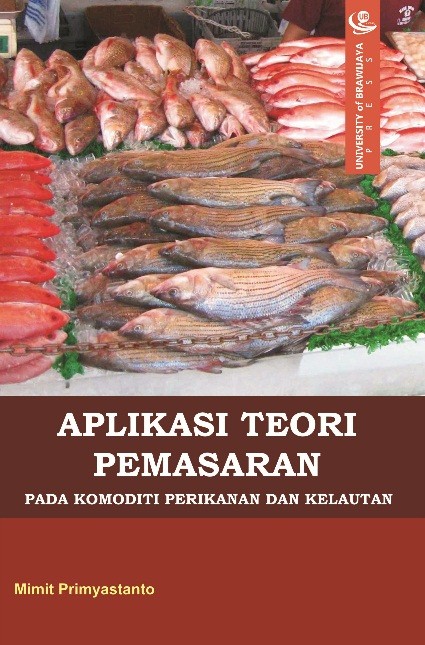| Title | : Aplikasi Teori Pemasaran pada Komoditi Perikanan & Kelautan |
| Author | : Mimit Primyastanto |
| Publisher | : Universitas Brawijaya Press |
| Edition | : I, Maret 2014 |
| Pages | : 228 pages |
| ISBN | : 978-602-203-610-4 |
| Price | : IDR 117.500 |
The fishing industry is one of the great potential that Indonesia has, given that the territorial waters of Indonesia is quite extensive, reaching 5.8 million miles, or approximately 70% of the entire region. This allows the fisheries sector to produce a great product with lots of variety. The economic potential of resources in the fisheries sector is estimated to reach US $ 82.29 billion per year, including the type of fishing effort, aquaculture, and marine biotechnology.
However, the facts indicate that the magnitude of the sea potential does not necessarily ensure the fisheries welfare industry to be stable and sustainable. The reason is complex, related to the government policy, private sector, fishermen, and even fishery commodity itself. Among them is a matter of fish marketing and sea products in traditional markets that are plagued with maintenance products system, where it is associated with pricing and adjustments to the purchasing power of consumers. There are several kinds of fish and marine products maintenance, namely the cold chain system, selling fresh fish, and fish preservation with low temperature. All three require different treatments that have different effects related to its distribution in the market.
The existence of a modern market is also being particular concern because of its existence will gradually shift the traditional market. The existence of modern markets such as minimarket and supermarkets are increasingly mushrooming in various areas would affect the interest of the public expenditure. Most people will probably switch to a modern market because it is cleaner, more comfortable, and more assured in products quality as compared with the traditional markets which tend to be just what it is. Although buyers in the traditional market can be more flexible in terms of price bargaining than in the modern market which the price is already fixed.
This book comes to offer the concept of marketing theory application in fisheries and marine commodity distribution. Business prospects of the fishery commodities such as eel, tuna, shrimp, fresh fish, red snapper, and even teri are discussed in marketing point of view in this book. Readers can find out from the marketing mix, consumer behavior, product attributes, the breakeven point analysis, analysis of demand and supply, management aspects, technical aspects, as well as strategies in the marketing of fish and other marine products. In details, this book also discussed about the costs and revenues as well as the elements that are attached to each seafood industry businesses. Each discussion blended with systematic and straightforward presentation so that the readers can easily understand the flow of ideas submitted by the author. This book can be used by fishery students or lecturers as teaching materials.
| Judul Buku | : Aplikasi Teori Pemasaran pada Komoditi Perikanan & Kelautan |
| Penulis | : Mimit Primyastanto |
| Penerbit | : Universitas Brawijaya Press |
| Cetakan | : I, Maret 2014 |
| Tebal | : 228 halaman |
| ISBN | : 978-602-203-610-4 |
| Harga Buku | : Rp 117.500 |
Industri perikanan merupakan salah satu potensi besar yang dimiliki Indonesia, mengingat bahwa wilayah perairan Indonesia cukup luas yaitu mencapai 5,8 juta km atau mendekati 70% dari keseluruhan wilayah. Hal ini memungkinkan sektor perikanan untuk menghasilkan produk yang besar dengan banyak ragam. Potensi ekonomi sumber daya pada sektor perikanan diperkirakan mencapai US$ 82,29 miliar per tahun, meliputi jenis usaha penangkapan, budidaya laut, dan bioteknologi laut.
Namun, fakta di lapangan menunjukkan bahwa besarnya potensi kelautan ini tidak serta merta menjamin kesejahteraan pelaku industri perikanan yang stabil dan berkelanjutan. Alasannya kompleks, berkaitan dengan andil pemerintah, swasta, nelayan, dan bahkan komoditi perikanannya itu sendiri. Diantaranya adalah soal pemasaran produk ikan dan laut di pasar tradisional yang terkendala dengan sistem pemeliharaan produk, dimana hal ini berhubungan dengan penentuan harga dan penyesuaian dengan daya beli konsumen. Ada beberapa macam tindakan pemeliharaan produk ikan dan laut, yaitu dengan cold chain system, penjualan ikan segar, dan pengawetan ikan dengan suhu rendah. Ketiganya memerlukan perlakuan yang berbeda dan mempunyai efek yang berbeda sehubungan dengan pendistribusiannya di pasaran.
Adanya pasar modern juga menjadi perhatian khusus karena eksistensinya lambat laun akan menggeser pasar tradisional. Keberadaan pasar modern seperti minimarket dan supermarket yang kian menjamur di berbagai daerah tentunya berpengaruh terhadap minat belanja masyarakat. Sebagian orang mungkin akan beralih ke pasar modern karena pasar modern lebih bersih, lebih nyaman, dan lebih terjamin kualitas produknya dibandingkan dengan pasar tradisional yang cenderung apa adanya. Meskipun di pasar tradisional pembeli bisa lebih luwes dalam soal tawar menawar harga daripada di pasar modern yang harganya sudah tetap.
Buku ini hadir dengan menawarkan konsep tentang aplikasi teori pemasaran pada distribusi komoditi perikanan dan kelautan. Prospek usaha komoditi perikanan seperti belut, ikan tuna, udang, ikan segar, kakap merah, hingga teri nasi dibahas lengkap per unsur pemasarannya dalam buku ini. Pembaca bisa mengetahui mulai dari bauran pemasaran, perilaku konsumen, atribut produk, analisis break even point, analisis permintaan dan penawaran, aspek manajemen, aspek teknis, serta strategi dalam proses pemasaran hasil ikan dan hasil laut lainnya. Secara lebih terperinci, dalam buku ini juga dibahas tentang biaya dan penerimaan beserta elemen-elemen yang melekat pada tiap usaha industri hasil laut. Tiap bahasan diracik dengan sistematis dan tidak bertele-tele sehingga pembaca dapat dengan mudah memahami alur ide yang disampaikan oleh penulis. Buku ini dapat digunakan oleh mahasiswa atau dosen sebagai materi ajar di bidang perikanan.
